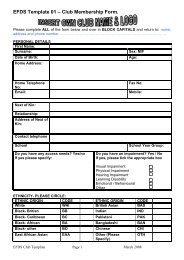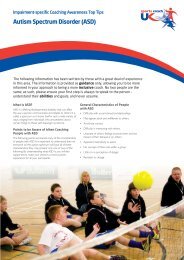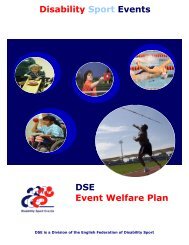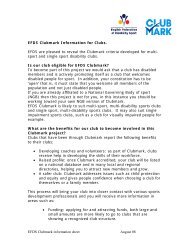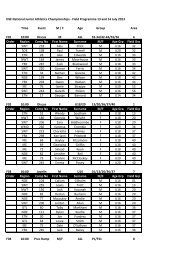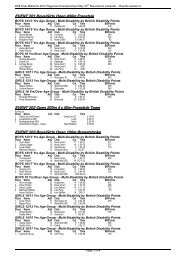OO213 - English Federation of Disability Sport
OO213 - English Federation of Disability Sport
OO213 - English Federation of Disability Sport
- No tags were found...
You also want an ePaper? Increase the reach of your titles
YUMPU automatically turns print PDFs into web optimized ePapers that Google loves.
CHAPTER 4ESSENTIALS OFPROTECTIONChildren with disabilities are among the most vulnerablemembers <strong>of</strong> society. They stand to benefit the most frommeasures to count them, protect them against abuseand guarantee them access to justice.Obtaining protection can be a particular challengefor children with disabilities. In societieswhere they are stigmatized and their familiesare exposed to social or economic exclusion,many children with disabilities are not even ableto obtain an identity document. Their births gounregistered: They might not be expected tosurvive, 103 their parents might not want to admitto them, or they might be considered a potentialdrain on public resources. This is a flagrant violation<strong>of</strong> these children’s human rights and a fundamentalbarrier to their participation in society.It can seal their invisibility and increase their vulnerabilityto the many forms <strong>of</strong> exploitation thatresult from not having an <strong>of</strong>ficial identity.States parties to the Convention on the Rights <strong>of</strong>Persons with Disabilities (CRPD) have given themselvesthe clear obligation to guarantee effectivelegal protection for children with disabilities. Theyhave also embraced the principle <strong>of</strong> ‘reasonableaccommodation’, which requires that necessaryand appropriate adaptations be made so thatchildren with disabilities can enjoy their rights onan equal basis with others. For resulting legislationand efforts to change discriminatory socialnorms to be meaningful, it is also necessary tomake certain that laws are enforced and childrenwith disabilities are informed about their right toprotection from discrimination and about how toexercise this right. Separate systems for childrenwith disabilities would be inappropriate. As withthe other aspects <strong>of</strong> life and society discussed inthis report, equity through inclusion is the goal.Abuse and violenceDiscrimination against and exclusion <strong>of</strong> childrenwith disabilities renders them disproportionatelyvulnerable to violence, neglect and abuse. Studiesfrom the United States have shown that childrenwith disabilities who are in preschool or youngerare more likely to be abused than peers withoutdisabilities. 104 A national survey <strong>of</strong> deaf adults inNorway found that girls were twice as likely toexperience sexual abuse, and boys three times aslikely, as peers who had no disability. 105 Childrenwho may already be suffering stigma and isolationhave also been shown to be more likely tosuffer physical abuse.Some forms <strong>of</strong> violence are specific to childrenwith disabilities. For example, they may be subjectto violence administered under the guise <strong>of</strong> treatmentfor behaviour modification, including electroconvulsivetreatment, drug therapy or electricshocks. 106 Girls with disabilities endure particularabuses, and in many countries are subject to forcedsterilization or abortion. 107 Such procedures aredefended on grounds <strong>of</strong> avoidance <strong>of</strong> menstruationor unwanted pregnancy, or even ascribed to amistaken notion <strong>of</strong> ‘child protection’, given the disproportionatevulnerability <strong>of</strong> girls with disabilitiesto sexual abuse and rape. 108 As <strong>of</strong> the beginning <strong>of</strong>ESSENTIALS OF PROTECTION41



